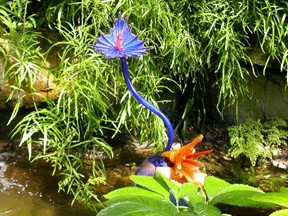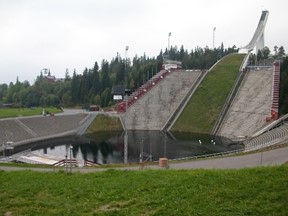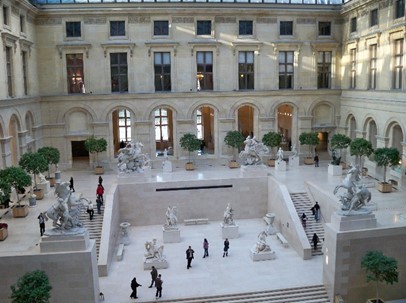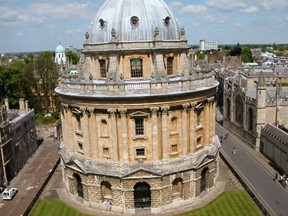© 2013 Rex Jaeschke. All rights reserved.
In Part 1, we covered Ancient Civilizations and Old Sites and Religious Places and Artifacts. In Part 2, we covered Royal Hangouts and Military-Related Places and Things.
Museums and Art Galleries
I've long had a saying, "If you don't understand it, it must be art!" And that certainly has proven true when I've looked at many paintings and sculptures. Without a doubt, there are times when I'm sure that my taste is entirely within my mouth! In any event, I've seen so many museums and art galleries that it's hard to know where to begin, so I'll charge right in going by country in no particular order.
After seven or eight trips to Denmark, I finally got to visit the Louisiana Museum of Modern Art. It stays open one night each week when the restaurant serves a fine dinner. I enjoyed the exhibits and the food, as well as looking at the Danish-made "practical/wearable art" on sale. On a separate trip, I dropped by the Viking Ship Museum in Roskilde, and as it was a slow day, a curator invited me for a behind-the-scenes tour where staff were restoring a ship. It's hard to imagine one taking such a small craft across an ocean.
Mainz, Germany, is a state capital, and was home to Guttenberg and his printing press. In fact, in 2000, he was named Man of the Millennium. The museum dedicated to him is worth a visit. [By the way, Mainz is just a short train ride from Frankfurt airport, if you should ever have a long layover there. However, should you ride there by train, be sure to keep in the half of the train that goes to Mainz rather than Wiesbaden, another state capital just across the river (he says from experience).]
Canada is home to some interesting collections. If you are in the Hull/Ottawa area, go see the (quite new and beautiful) Canadian Museum of Civilization. The greater Vancouver area has plenty of things to see, including: Vancouver Maritime Museum and its St. Roch, the first ship to completely circumnavigate North America; Queen Elizabeth Park with its geodesic dome; and the extensive collection at the Museum of Anthropology at the University of British Columbia, which covers all the Pacific Island nations as well as New Zealand's Maoris and Australia's Aborigines.
 In the US, the greater Detroit, Michigan, area hosts the Henry Ford Museum and Greenfield Village, the Holy Grail for transportation enthusiasts. The village contains the original buildings or homes of some famous Americans. The Rodin Collection at Stanford University is worth a look as are the campus grounds. During my first year in the US I lived in Chicago, so I just had to make a pilgrimage to the Chicago Art Institute to see Andy Warhol's famous soup cans. Dale Chihuly is an American glass sculptor. I first became aware of his work during a visit to the Missouri Botanical Garden in St. Louis, where his sculptures were placed throughout the garden (see the photo to the left with the blue and orange sculpture). Fairbanks, Alaska, has the University of Alaska Museum of the North. Seattle's Museum of Flight is definitely worth a visit as is Boeing's tour of the B747, 767, 777, and 787 assembly lines. On a visit to Santa Fe, the state capital of New Mexico, I dropped by the Georgia O'Keefe Museum. This often-misunderstood artist was well ahead of her time. New York City boasts many cultural centers: Ones that immediately come to mind are The Museum of Modern Art (MoMA); American Museum of Natural History (which includes the Hayden Planetarium); the Ellis Island Museum, which shows how the millions of immigrants arriving there were processed and often given Anglicized names; The Guggenheim; and Intrepid Sea-Air-Space Museum. The National Gallery of Art is on the Mall in downtown Washington DC. During the summer, the fountain water runs down the outside walls of the underground cafeteria. I especially love the outdoor sculpture garden next door, whose very large fountain becomes an ice-skating rink in winter. On a motorhome trip through South Dakota, I stumbled on the Mammoth Site museum near Hot Springs, build over a dig with partially exposed, complete skeletons of numerous mammoths. One of the best known, most visited, and free museum and gallery complexes is Washington DC's Smithsonian Institution. [The donation of the original funding is most interesting.] Opened in 1976 for the Bicentennial, the Air and Space Museum is the most-visited museum in the world, complete with touchable piece of moon rock and magnificent movie theater. The nicely renovated Museum of Natural History is also impressive.
In the US, the greater Detroit, Michigan, area hosts the Henry Ford Museum and Greenfield Village, the Holy Grail for transportation enthusiasts. The village contains the original buildings or homes of some famous Americans. The Rodin Collection at Stanford University is worth a look as are the campus grounds. During my first year in the US I lived in Chicago, so I just had to make a pilgrimage to the Chicago Art Institute to see Andy Warhol's famous soup cans. Dale Chihuly is an American glass sculptor. I first became aware of his work during a visit to the Missouri Botanical Garden in St. Louis, where his sculptures were placed throughout the garden (see the photo to the left with the blue and orange sculpture). Fairbanks, Alaska, has the University of Alaska Museum of the North. Seattle's Museum of Flight is definitely worth a visit as is Boeing's tour of the B747, 767, 777, and 787 assembly lines. On a visit to Santa Fe, the state capital of New Mexico, I dropped by the Georgia O'Keefe Museum. This often-misunderstood artist was well ahead of her time. New York City boasts many cultural centers: Ones that immediately come to mind are The Museum of Modern Art (MoMA); American Museum of Natural History (which includes the Hayden Planetarium); the Ellis Island Museum, which shows how the millions of immigrants arriving there were processed and often given Anglicized names; The Guggenheim; and Intrepid Sea-Air-Space Museum. The National Gallery of Art is on the Mall in downtown Washington DC. During the summer, the fountain water runs down the outside walls of the underground cafeteria. I especially love the outdoor sculpture garden next door, whose very large fountain becomes an ice-skating rink in winter. On a motorhome trip through South Dakota, I stumbled on the Mammoth Site museum near Hot Springs, build over a dig with partially exposed, complete skeletons of numerous mammoths. One of the best known, most visited, and free museum and gallery complexes is Washington DC's Smithsonian Institution. [The donation of the original funding is most interesting.] Opened in 1976 for the Bicentennial, the Air and Space Museum is the most-visited museum in the world, complete with touchable piece of moon rock and magnificent movie theater. The nicely renovated Museum of Natural History is also impressive.
The Hermitage in St. Petersburg, Russia, is world-famous. (My Russian guide asked me to keep quiet as we bought tickets, as foreigners were charged ten times the price of Russians!) I have never been a fan of gold or gilded anything, and this place was "over-the-top" in this regard.
 During various trips to beautiful Oslo, Norway, I visited Norsk Folkemuseum, the Viking Ship Museum, the Kon-Tiki Museum, the Nobel Peace Center, and Holmenkollbakken, an impressive ski jump (pictured at the left).
During various trips to beautiful Oslo, Norway, I visited Norsk Folkemuseum, the Viking Ship Museum, the Kon-Tiki Museum, the Nobel Peace Center, and Holmenkollbakken, an impressive ski jump (pictured at the left).
Dublin, Ireland has plenty of culture, which includes museums with peat-bog mummies, and the Book of Kells ("an illuminated manuscript Gospel book in Latin") and harp (the symbol of Ireland) in Trinity College. The bridges over the River Liffey are especially worth a look. The new Samuel Beckett Bridge is built to look like a harp, complete with numerous cables as strings.
The UK has loads of places for art and old stuff. For me, the Number 1 place has to be the British Museum where I always visit the Rosetta Stone, which allowed scholars to first understand Egyptian hieroglyphics. Outdoors, along the Embankment (an area on the north side of the Thames River), I like to visit the Cleopatra's Needle obelisk and its adjacent sphinxes. There is a shrapnel hole in one sphinx that resulted from a bomb dropped during WWI. Prior to last year, I'd never visited any of the Tate galleries. However, during a vacation in the county of Cornwall, I stopped off at the Tate St. Ives. (It's not often that pieces in galleries grab me, but two did there: a piece of paper covered in tea stains around the image of a tea cup base, with colored ribbons stitched around the stain's edge; and a long cloak covered in used tea bags. You probably have to see them to understand.) A companion gallery is The Barbara Hepworth Museum and Sculpture Garden. (I can safely say that nothing of that acclaimed artist's work interested me, but I was very impressed with all the large and complex spider webs in shrubs in the garden, most with working spiders!)
If you are ever in Tokyo, Japan, the place for museums is Ueno Park. Standing there in front of the National Museum of Western Art is one of Rodin's Thinker sculptures.
To visit all the biggies in Vienna, Austria, would take much more time than most visitors can spare. Highlights for me included Schloss Schönbrunn, the former summer residence of the Habsburgs (the Palm House indoor garden was especially impressive); Hofburg Palace, a sprawling complex of buildings and grounds where the Vienna Boys' Choir performs, the President and Chancellor have their offices, and there are numerous museums and the national library; Hundertwasserhaus, "a fairytale-like house with onion spires, green roof [as in trees and gardens growing on it], and a multicolored façade is one of the city's most frequently visited landmarks (It was designed by flamboyant Austrian artist Fruedensreich Hundertwasser as a playful take on usually dull council housing)"; the Upper Belvedere Palace built in Baroque style with extensive gardens (there are three floors of paintings with many works by Gustav Klimt including his famous The Kiss, along with masterpieces by other notable painters); and the world-famous Spanish Riding School. [The horses were originally brought from Spain, hence the name. Later, many came from a stud in Lipica (spelled Lipizza in Italian), in modern-day Slovenia, hence the name Lipizzaner.
 Like many European capitals, Paris, France, is "right up to here" with art and museums, far too numerous to enumerate here. To me, for its small size, the Musée d'Orsay is hard to beat. Built in a former railway station, the building is as interesting as its contents. (See photo at left). Then there's the Musée du Louvre. I freely admit that before I first saw the Mona Lisa, I was expecting it to take up a whole wall it was so "big" in story. But, in reality, it's really quite small and when there is a crowd around it, it can be hard to see! One exhibit there that interested me greatly was Hammurabi's Code, a "well-preserved Babylonian law code, dating back to about 1772 BC" carved in stone. [Americans are often portrayed as "being in a hurry", and a very funny cartoon along those lines shows an American tourist telling his taxi driver, who has just dropped him at the entrance to the Louvre, to "Keep the engine running, I won't be long".]
Like many European capitals, Paris, France, is "right up to here" with art and museums, far too numerous to enumerate here. To me, for its small size, the Musée d'Orsay is hard to beat. Built in a former railway station, the building is as interesting as its contents. (See photo at left). Then there's the Musée du Louvre. I freely admit that before I first saw the Mona Lisa, I was expecting it to take up a whole wall it was so "big" in story. But, in reality, it's really quite small and when there is a crowd around it, it can be hard to see! One exhibit there that interested me greatly was Hammurabi's Code, a "well-preserved Babylonian law code, dating back to about 1772 BC" carved in stone. [Americans are often portrayed as "being in a hurry", and a very funny cartoon along those lines shows an American tourist telling his taxi driver, who has just dropped him at the entrance to the Louvre, to "Keep the engine running, I won't be long".]
During one trip to Milano, Italia, (he pronounces with appropriate hand gestures) I dropped in to see DaVinci's Last Supper. [I recall a very funny sketch on US TV's Saturday Night Live in which Father Guido Sarducci, a comedian dressed as a Catholic priest, shows the host a copy of the bill for said supper, which he'd bought at a flea market in New York City.]
Libraries
Okay, I admit it; I'm a non-recovering bookaholic, so let's start with the Grand Daddy of them all, the Library of Congress in Washington DC. It was started when the US Congress bought Thomas Jefferson's entire personal collection, in 1815. According to Wikipedia, "The collections … include more than 32 million cataloged books and other print materials in 470 languages; more than 61 million manuscripts; the largest rare book collection in North America, including the rough draft of the Declaration of Independence, a Gutenberg Bible (one of only four perfect vellum copies known to exist); over 1 million US government publications; 1 million issues of world newspapers spanning the past three centuries; 33,000 bound newspaper volumes; 500,000 microfilm reels; over 6,000 comic book titles; films; 5.3 million maps; 6 million works of sheet music; 3 million sound recordings; more than 14.7 million prints and photographic images including fine and popular art pieces and architectural drawings; the Betts Stradivarius; and the Cassavetti Stradivarius." And unlike most libraries, one can't ordinarily borrow books, as they are there for research purposes. In my numerous visits there, I have never actually looked at any of the regular collection. What impresses me are the extensive murals and tile work, and the view of the main reading room and statuary from the overlook halfway up the dome.
 The British Library "is the national library of the United Kingdom. It's a major research library, holding over 150 million items from many countries, in many languages and in many formats, both print and digital: books, manuscripts, journals, newspapers, magazines, sound and music recordings, videos, play-scripts, patents, databases, maps, stamps, prints, drawings. The Library's collections include around 14 million books, along with substantial holdings of manuscripts and historical items dating back as far as 2000 BC." Originally part of the British Museum, it moved to its own, new home in 1973, right next door to the beautifully restored St. Pancras railway station. The huge bronze sculpture, NEWTON, in the courtyard is worth some study. For me, the highlight was a sort of National Treasures room that housed manuscripts from Beowulf, various Gospels, a Gutenberg Bible, Chaucer's Canterbury Tales, copies of pages from the Magna Carta, some very beautiful Korans, and the lyrics of a Beatle's song hand-written on an airline napkin. In one room, I paged through a digital version of some of Leonardo da Vinci's notebooks. [He wrote left-handed, and back-to-front, so a reader needed a mirror! I ask you, is that normal?] During one visit, I got to go on a behind-the-scenes tour of the restoration area where I watched someone restoring a 1,500-year-old Japanese scroll. The Radcliffe Camera in Oxford is a most striking building; it houses the Radcliffe Science Library. (See photo above.)
The British Library "is the national library of the United Kingdom. It's a major research library, holding over 150 million items from many countries, in many languages and in many formats, both print and digital: books, manuscripts, journals, newspapers, magazines, sound and music recordings, videos, play-scripts, patents, databases, maps, stamps, prints, drawings. The Library's collections include around 14 million books, along with substantial holdings of manuscripts and historical items dating back as far as 2000 BC." Originally part of the British Museum, it moved to its own, new home in 1973, right next door to the beautifully restored St. Pancras railway station. The huge bronze sculpture, NEWTON, in the courtyard is worth some study. For me, the highlight was a sort of National Treasures room that housed manuscripts from Beowulf, various Gospels, a Gutenberg Bible, Chaucer's Canterbury Tales, copies of pages from the Magna Carta, some very beautiful Korans, and the lyrics of a Beatle's song hand-written on an airline napkin. In one room, I paged through a digital version of some of Leonardo da Vinci's notebooks. [He wrote left-handed, and back-to-front, so a reader needed a mirror! I ask you, is that normal?] During one visit, I got to go on a behind-the-scenes tour of the restoration area where I watched someone restoring a 1,500-year-old Japanese scroll. The Radcliffe Camera in Oxford is a most striking building; it houses the Radcliffe Science Library. (See photo above.)
Dublin, Ireland boasts the Trinity College Library, which I mentioned in Part 1 with respect to the Book of Kells. Not far from there is the Chester Beatty Library, which holds the Islamic and Asian works collected by the American mining magnate.
Weimar, Germany, is home to Herzogin Anna Amalia Bibliothek (Duchess Anna Amalia Library). The original building is something to see although quite a bit of it and its collection was destroyed by fire just weeks before the contents were to be moved to the new building across the plaza.
I have a particular interest in US Presidential history, and have visited two presidential libraries: Richard Nixon's in California and LBJ's in Texas.
Aquariums
Once you've seen some really spectacular ones, all others pale by comparison. Monterey, California, is home to Monterey Bay Aquarium; Orlando, Florida, has the EPCOT Center's The Seas; Chicago, Illinois, has the Shedd Aquarium; and Bergen, Norway, has an impressive aquarium.
Conclusion
In Part 4, we'll look at Gardens, Theme Parks, Parliament Houses and Capitals, National Parks and Historic Places, and a few Odds and Ends.